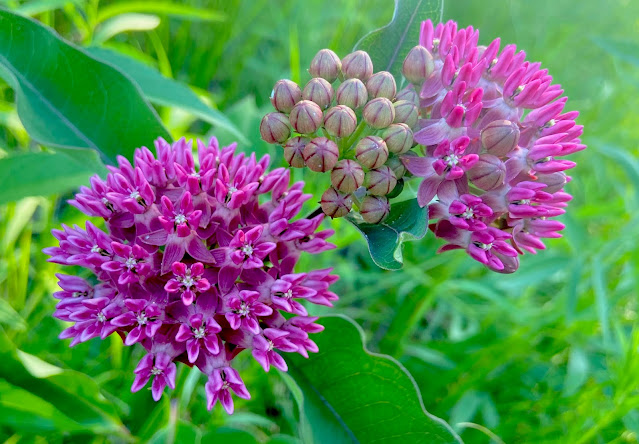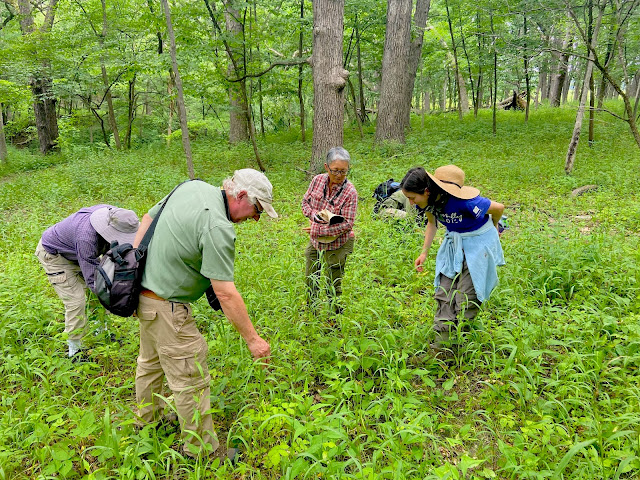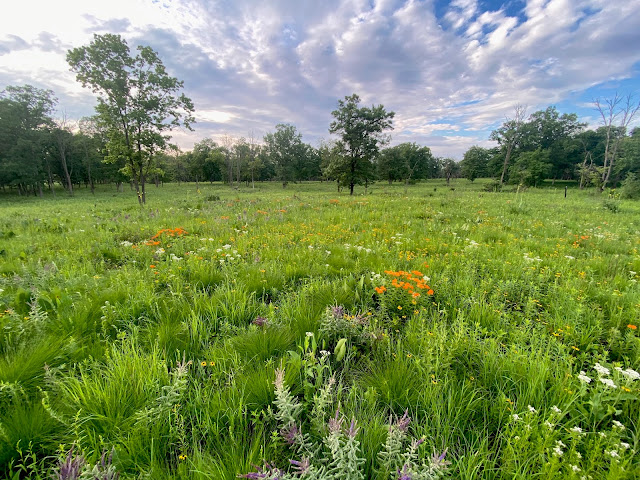Aldo Leopold
Yes and no. The bright colors and diverse foliage here suggest health and quality; they came together by their own agency as part of the healing process. But there are times when a weed field will be colorful. To truly appreciate the ecosystem, it helps to learn the plants names, and what the various species tell us.
The plants most obvious above are butterfly milkweed (orange), wild bergamot (lavender), and narrow-leaved mountain mint (white). There are at least a dozen other species easily identifiable if you "know your plants." They are quality native plants. But none are the
high conservatives that would indicate full ecosystem health.
Why are so many trees dead in the somewhat similar photo below?
Are dead trees ugly?
Or do you even notice them, with all that early July color in the foreground?
The dead trees were invaders. Disease and controlled fire killed them.
There's a great drama under way here, and perhaps subsequent photos (and a
later blog post) will give insights into it. In the foreground, quality restoration is well under way. Underneath those trees in the background there was, and still is, no color - only marginally improved biodiversity as least for now - just dull green and the brown of bare dirt.
Next photo: The fire that destroys trees comes to Somme Prairie Grove in many ways. The photo below was taken at the edge of a bonfire pile 'burn scar' from last winter.
The plant is Bicknell's geranium - recognized as an Endangered species in Illinois. It's the only plant of its species we've found so far this year. We hope there's another one, and the pollen grains from the hypothetical two can find their ways to each other's ovaries.
We only see Bicknell's geranium where a hot
wood fire has sterilized the soil. That's its habitat, and its role in the ecosystem is to begin the recycling of burned soil. A brush pile burn is the modern counterpart to a great dead tree falling and burning in a lightning- or Potawatomi-ignited fire. This geranium and many species in many ways have an evolving relationship with fire going back millions of years.
And now a photo that illustrates a partial failure, so far.
Here, formerly under invasive trees, but no longer, the bare dirt and lack of diversity seem to be a function of a different kind of lack of fire. Woodland sunflower has become dominant and apparently has excluded most other vegetation in an area that didn't burn because of not enough fuel. Fires in this preserve depend on two major fuel types - warm-season grasses and oak leaves. This area has neither. Here, as shown in the foreground,
we are scything the sunflowers as an experiment to see whether we can restore diverse fuel species to this area.
The photo below, from 2019, shows how one corner of a different, square scything-woodland-sunflower experiment looked that August.
The yellow sunflower is in bloom in the background, where it was not scythed. The not-now-blooming but more-diverse younger plants of other species are green in the foreground. This differently-conceived experiment (within a grove where there is sufficient oak leaf fuel for a fire but seemed to be losing diversity for other reasons) was started in 2017 and seems inconclusive so far.
If you walk the trails, you may notice many experiments under way at the Somme preserves. In this case a prairie lily peeks out of a deer-exclusion cage. Prairie lily is a rare and highly conservative plant. If you'd like a quick intro to what "conservative" means to a plant, click
here. If you want lists of conservative species and more detail on the concept, check
here and go to the middle of the post.

The prairie lily (in contrast to the Michigan lily) is generally found only in very-high-quality prairies and savannas. For decades, fewer than half a dozen bloomed each year in Somme Prairie - and none at all in Somme Prairie Grove. Then we began protecting them from deer and voles with cages. Now scores of them bloom annually in both Nature Preserves.
(The much-commoner Michigan lily does not have those proud, upward facing flowers. This equally beautiful and commoner lily has petals that arch around nearly into a circle and flower stems that gracefully arch over so the flower faces downward.)

On the other hand, recovery of ecosystem diversity and health is not a straight line. The Somme preserves were subjected to a severe drought for the first half of the 2021 growing season. The tall exclusion cage (above) was constructed for the height lilies attained last year. In 2021, they're not that tall. Natural ecosystems have evolved to weather diverse stresses - within gradually-changing parameters. We expect the recovery to go through twists and turns.
For the lily, we hope that, as with some other species, there may someday be sufficiently many plants (and perhaps more vole and deer predation) that we can dispense with the cages.
Deer sometimes like to eat purple milkweed, a characteristic savanna species. This uncommon plant increased dramatically under the influence of prescribed burns, as the seed from a few plants blew about the preserve. (We did little or nothing special to help them. That's true for most of the 490 species in this savanna. Others (especially some of the high conservatives that will one day be the core of the ecosystem) need various kinds of intensive care, at least for a while.

The photo above gets at questions about beauty from another angle. Compelling aesthetics are often associated with high quality ecosystems. Diverse shapes and colors certainly stir the senses of people who know what they're looking at (and make it easier to convey to others why we find these places special). But there are times when a super-conservative ecosystem will be all green. And there are times when a weed patch may be very colorful.
The photo also helps make a point about the restoration process. This fairly rich area has an unusual abundance of black-eyed Susans. All the other species we see here are long-lived perennials. But black-eyed Susans live for just two years. Like the Bicknell's geranium, this is a species that helps heal ecosystem wounds. Two years ago something happened that left bare ground. The Susans colonized that space but (like all biennials) did not bloom. This year they're dramatically colorful and will set seeds ... and die. Then those seeds will wait for another opportunity. In high-quality grasslands, the Susans are regular, but just here and there, helping to heal this and that. But in the area above, something happened (as illustrated in two photos, below) that resulted in a lot of opportunities for new plant establishment. These happy blooms therefore remind us that this would likely be a good place to plant some of our rare conservative seed this fall.
Other species in the photo above: The big white flower clusters are wild quinine. The little white ones are fleabane (another disturbance-healing biennial like black-eyed Susan). The big leaves (not blooming yet and likely to wait until next year) are prairie dock. The big clumps of dense, fine grass are prairie dropseed, the most conservative of our warm-season grasses. In the background are masses of the whitish leaves and purple flowers of leadplant.
Above, bare gray branches stand over dead brown leaves. An invading Asian honeysuckle had shaded out and killed off about three square feet of natural ecosystem. This spring's burn had killed the woody above-ground parts, but not the roots. Thousands of these re-sprouting invaders have killed off thousands of three to six-square-foot patches year after year, for the forty years the Somme Team has been restoring here.
In the past few years increasingly, Eriko Kojima, Christos Economou, Sai Ramakrishna, Katie Kucera and others have been carefully spraying an herbicide on the post-burn emerging new sprouts. Soon this problem should be a thing of the past. The area of the black-eyed Susans in the previous slide was one of the areas that had a bad case of re-sprouting invasives until spraying two years ago. That's likely the reason the black-eyed Susans are heralding an opportunity for a "great leap forward" in ecosystem recovery.
Dead buckthorn. Same story. Note that the surrounding vegetation seems little impacted by the herbicide.
Hairstreak butterfly. Eriko asked me to snap its photo because she wants to have lots of images to share on Facebook with the Somme Team. I'm tossing it into this post to remind myself and you that the work here is as much about animals as plants. As is typical of quality ecosystems, the rare plants here likely support an even larger number of rare animals. Burning as often as we can safely manage is probably best for most of the savanna plant species. Too much burning may harm some of the animal species, so we try always to maintain some unburned habitats.

Speaking of Eriko, she also takes great pleasure in working, learning, and leading. Except in special cases, we take photos from the paths, to avoid trampling.

Speaking of Sai, Eriko, and Katie, they're the middle three here, on a Friends of Illinois Nature Preserves "field seminar" at Swallow Cliff Woods, where burning by forest preserve staff has had wonderful impact.
More often, seminar participants look like this ... studying the plants and animals to figure out how we can learn to be better stewards ... and to satisfy our mutual itches to know, experience, and celebrate.
Now we're back in Somme Prairie Grove, agonizing over next steps. The burn scar here is a minor problem. It will be well into its natural successional process in a year or two. But the woodland sunflower and tall goldenrod around it concern us. They resist fire. Areas that don't burn will revert to woody invaders before long.

Step forward a few paces and you can see stumps of two of the large trees that were cut here and burned in that pile. These unnatural trees stood over impoverished vegetation. And with the sudden increase in light, two aggressive species began taking over. We will scythe them wholesale for a couple of years while seeding to promote more diversity. We get the sense that under some circumstances this approach restores a high-quality and sustainable plant community ... and under other circumstances it does not. The various approaches are being studied by the Somme Team ( in part coordinated by Karen Glennemeier with a grant from the Illinois Native Plant Society). We learn and report.

This is a somewhat similar area. But here, quality plants are mixed with the aggressive ones. Would the aggressives kill off the diverse quality species? Or would quality tame the aggressives? In this case, we will surgically scythe the woodland sunflower and tall goldenrod here while protecting the other species. Nearby similar areas will be left along as controls. This same patch after scything is shown below.
This is the same scene, after scything (and removing the scythed material for this photo, so it's easier to see what is left). From the foliage, we can identify cream gentian, wild quinine, golden Alexanders, wild strawberry, rattlesnake master, prairie dock, pale Indian plantain, Culver's root, agrimony, pasture thistle, early goldenrod, Virginia anemone, and others including semi-suppressed grasses and sedges that may make a critical component of the fuel for the fires that may foster increasing quality of this area over the long haul.
What are the grasses that may ultimately thrive with these associates? The one making the best showing here is wide-leaved panic grass, shown below:
In semi-shaded areas, this grass picks up enough sun thanks to its very wide (for a grass) leaves.
In an even shadier area, with lots of oaks and sedges, there's plenty of fuel for fire to repel invaders. The blue flowers belong to heart-leaved skullcap. Those lines arching across this photo are sedges whose long flower stalks seem to be reaching out to plant the seeds just a bit farther away from the mother plant.
Here, in the very open savanna, the fires maintain impressively increasing diversity, but perhaps do it too well for some species? Those clumps of shrubby growths here and there are bur and scarlet oak re-sprouts. They have burned off and stayed small for more than forty years now. The prairie species are doing great! In this former savanna, the "in between" species (not too dark and not too bright) would thrive better if some of the oaks were allowed to grow bigger. For some years now, we've begun working to promote oak reproduction in some areas, as shown below:
Here two young bur oaks are protected from deer and rabbits in cages. After four decades, we'd waited too long for oak reproduction.
We had protected this young bur oak from deer and fire - but then bucks started scraping the bark off the trunk with their antlers. So an additional cage was added to discourage that. It worked. On the other hand, there's a downside to this tree's growing success. Soon it will begin to shade out some of the full-sun dependent species, that we worked so hard to restore here. But the higher goal is to restore the full savanna community, so we'll now work to restore the species of the "in between" - neither full sun nor shade.
Among the species that seem to do better in dappled light than in the open prairie is Canada milk vetch, the yellow-flowered plant here. At Somme it seems to fade out of the full sun areas as they recover conservative quality, but they and many other species are expected to increase near growing trees.
In the photo below, three stages of the drama are visible. In the far distance, through a hole in the trees, is a peek at the completely treeless Somme Prairie. In the foreground is high-quality savanna grassland, with bur and scarlet oaks starting to "grow up to be real trees." Thus, the "in between" species will here increase at the expense of the species more typical of the prairie. In the middle distance are stands of (mistakenly planted, in the current context) white oaks and miscellaneous spontaneous trees ...
... and the plan there is not clear. Perhaps some of those middle-distance oaks will be saved, here and there, with most invader trees removed, and the mix of prairie and savanna grasses and wildflowers seeded in as needed. Savanna restoration is new. There is no place like this on the planet. It's a pleasure and an honor for so many of us to participate in this recovery.
Thanks for joining us to consider images and thoughts of late June and early July 2021.
This post also is a friendly invitation to you to come, learn, and enjoy.
More participants, leaders, and experimenters are always welcome on the Somme Team.
Thanks to Eriko Kojima and Christos Economou for edits and proofing.
Thanks to Forest Preserve staff for annual controlled burns and much other support.
Thanks to decades of hundreds of volunteer stewards for most everything.
 The photo above gets at questions about beauty from another angle. Compelling aesthetics are often associated with high quality ecosystems. Diverse shapes and colors certainly stir the senses of people who know what they're looking at (and make it easier to convey to others why we find these places special). But there are times when a super-conservative ecosystem will be all green. And there are times when a weed patch may be very colorful.
The photo above gets at questions about beauty from another angle. Compelling aesthetics are often associated with high quality ecosystems. Diverse shapes and colors certainly stir the senses of people who know what they're looking at (and make it easier to convey to others why we find these places special). But there are times when a super-conservative ecosystem will be all green. And there are times when a weed patch may be very colorful. 


























Thanks for the walk through with these beautiful pictures. Very valuable information, particularly how you are dealing with aggressive natives like woodland sunflower and goldenrods.
ReplyDeleteInformative and beautiful! Can you provide the dimensions (Height, circumference, mesh size)of the vole exclusion cages that you now use? How do you fasten them to the ground?
ReplyDeleteIs the "Buckthorn" referenced in this blog Carolina buckthorn (Rhamnus caroliniana) or something else? I'm new at this native plant throne and I thought Carolina buckhorn was a "good" species for ecology. Is it just that it's misplaced in the savannah? Thanks, Wendy Williams
ReplyDeleteTo Wendy: The buckthorn referred to is Rhamnus cathartica - a European species. It is "malignant" in that it grows uncontrollably and kills off most other species if left to its own devices. For more about this, check out: https://woodsandprairie.blogspot.com/2014/10/weed-alien-invasive-malignant.html.
ReplyDeleteNative buckthorns are rare in northern Illinois where I work. I've never seen one.